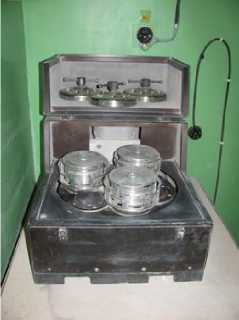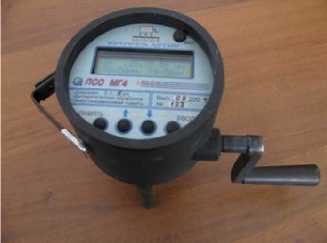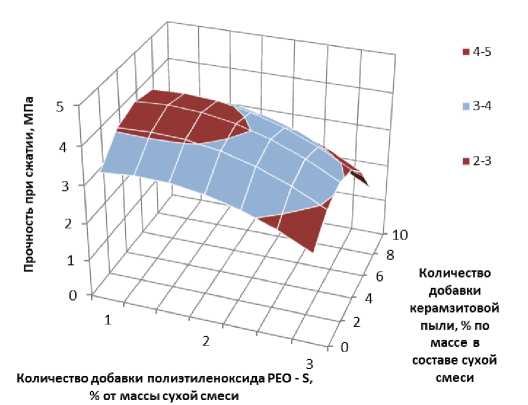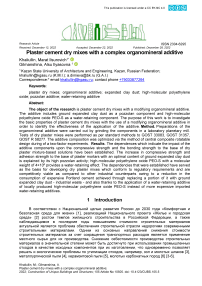Смеси сухие штукатурные цементные с комплексной органоминеральной добавкой
Автор: Халиуллин М.И., Гильманшина А.И.
Журнал: Строительство уникальных зданий и сооружений @unistroy
Статья в выпуске: 7 (105), 2022 года.
Бесплатный доступ
Объектами исследования являются сухие строительные смеси на основе штукатурного цемента с модифицирующей органоминеральной добавкой. В состав добавки в качестве пуццоланового компонента входит молотая керамзитовая пыль, а в качестве водоудерживающего компонента – высокомолекулярный полиэтиленоксид ПЭО-С. Целью данной работы является исследование основных свойств сухих строительных смесей на основе штукатурного цемента с использованием модифицирующей органоминеральной добавки для выявления эффективности применения добавки.
Сухие штукатурные смеси, органоминеральная добавка, керамзитовая пыль, высокомолекулярный полиэтиленоксид, пуццолановая добавка, водоудерживающая добавка
Короткий адрес: https://sciup.org/143182687
IDR: 143182687 | УДК: 69 | DOI: 10.4123/CUBS.105.5
Текст научной статьи Смеси сухие штукатурные цементные с комплексной органоминеральной добавкой
В соответствии с Национальной целью развития России до 2030 года «Комфортная и безопасная среда для жизни» [1], реализацией Национального проекта «Жилье и городская среда» [2] ростом темпов жилищного строительства в Российской Федерации, а также наблюдающимся в последние годы повышением стоимости строительных материалов актуальной является проблема обеспечения строительной отрасли недорогими современными строительными материалами. Одним из основных направлений снижения стоимости строительных материалов за счет сокращения транспортных расходов является применение местного сырья для их производства. Снижение себестоимости производства строительных материалов в значительной степени может быть достигнуто при использовании промышленных отходов в качестве исходных компонентов при их изготовлении, что одновременно позволяет решать и экологические проблемы по утилизации отходов, например, зол и молотых шлаков [3], металлургической пыли [4], керамзитовой пыли [5], молотых карбонатных пород [6] [3-6].
Одним из известных способов удешевления строительных материалов и изделий является введение в состав композиций для их изготовления оптимально подобранных по виду и количеству минеральных наполнителей на основе молотого природного сырья или промышленных отходов, обеспечивающих улучшение или сохранение по сравнению с бездобавочными образцами основных показателей физико-механических и технологических свойств получаемой продукции при снижении расхода более дорогостоящих вяжущих веществ, например, цементных [7], гипсовых [8], гипсоцементнопуццолановых [9, 10], полимерных [11]. Тонкодисперсная минеральная пуццолановая добавка, вводимая в вяжущие композиции на основе извести [12], портландцемента [13], гипсоцементнопуццоланового вяжущего [14], при взаимодействии с другими продуктами твердения вяжущих веществ, за счет новообразованных фаз может играть активную роль в формировании структуры твердеющей композиции, обеспечивая рост показателей основных физико-механических свойств по сравнению с бездобавочными составами.
При производстве керамзитового гравия серьезную проблему представляет утилизация образующегося отхода – керамзитовой пыли, которая собирается в системах пылеочистки – пылеосадительных камерах, циклонах, фильтрах. На крупных керамзитовых заводах ежесуточно может образовываться до 7-8 т керамзитовой пыли [15]. В дальнейшем этот отход могут возвращать в производственный цикл, добавляя к сырой глине [16], но чаще его вывозят в отвалы [17].
Керамзитовая пыль содержит в своем составе аморфную кремнийсодержащую фазу, которая может отличаться высокой химической активностью по связыванию гидроксида кальция с образованием прочных и труднорастворимых продуктов. Исследованиями, проведенными в ЗАО «НИИКерамзит» и Самарском государственном архитектурно-строительном университете [18], установлено, что введение в состав пенобетонной смеси керамзитовой пыли, которая выполняет роль активного микронаполнителя, позволяет значительно снизить усадку пенобетонных изделий, их плотность и теплопроводность. По своему химическому и минеральному составу керамзитовая пыль является некоторым аналогом молотой термоактивированной глины, для которой в ряде исследований установлена высокая эффективность применения в качестве активной пуццолановой добавки к извести [19], портландцементу [20], шлакощелочным вяжущим [21].
Прочность твердеющих растворных смесей увеличивается в процессе гидратации минеральных вяжущих. При быстром удалении воды из тонких слоев раствора в условиях нормальной атмосферной влажности и поглощения ее пористой подложкой гидратационные процессы нарушаются и прочность штукатурного раствора снижается. В настоящее время при получении сухих строительных смесей, в том числе штукатурных, в качестве водоудерживающих добавок в основном применяются дорогостоящие импортные продукты на основе эфиров целлюлозы [22]. Замена таких добавок на отечественные продукты аналогичного функционального действия является актуальной задачей, направленной на достижение технологического суверенитета в стройиндустрии. В работах [23, 24] показана эффективность применения некоторых водорастворимых полимеров отечественного производства, например, полиэтиленоксида (ПОЭ) с молекулярной массой 1,52×106 в качестве водоудерживающих добавок в бетонные и растворные смеси. Эффективность введения добавок полиэтиленоксидов с более высокой молекулярной массой в состав штукатурных растворов на основе портландцемента, в том числе в сочетании с добавкой керамзитовой пыли, не исследовалась.
Организация технологического процесса получения штукатурных цементных сухих смесей с применением в качестве пуццоланового компонента молотой керамзитовой пыли и высокомолекулярного полиэтиленоксида в качестве водоудерживающего компонента может предусматривать предварительное приготовление на основе этих компонентов модифицирующей органоминеральной добавки в результате предварительного размола керамзитовой пыли до требуемой величины удельной поверхности совместно с высокомолекулярным полиэтиленоксидом и последующим смешиванием полученной органоминеральной добавки с другими отдозированными компонентами сухой смеси. Эффективность применение органоминеральных модификаторов, полученных предварительным совместным помолом исходных компонентов, что обеспечивает высокую степень равномерности распределения модифицирующих добавок в композициях на основе минеральных вяжущих, показана для цементов низкой водопотребности [25] и композиционных гипсовых вяжущих [21].
Целью данной работы явились исследования по определению влияния модифицирующей органоминеральной добавкой, включающей молотую керамзитовую пыль в качестве пуццолановой добавки и высокомолекулярный полиэтиленоксид в качестве водоудерживающей добавки на показатели основных физико-механических свойств растворных смесей и растворов на основе штукатурных цементных сухих смесей для определения эффективности применения добавки, с точки зрения, обеспечения нормативных показателей основных физико-механических свойств и возможности удешевления штукатурных сухих смесей за счет снижения расхода и замены более дорогостоящих компонентов смесей.
Новизна представленной работы заключается в том, что получены математические зависимости, характеризующие влияние компонентов модифицирующей органоминеральной добавки в составе штукатурных цементных сухих смесей: пуццоланового компонента – молотой до удельной поверхности 300 м2/кг керамзитовой пыли и водоудерживающего компонента – высокомолекулярного полиэтиленоксида с молекулярной массой 4×106 на прочность при сжатии и прочность сцепления с основанием штукатурных растворов. Повышение прочности при сжатии и прочности сцепления с основанием штукатурных растворов при оптимальном содержании молотой керамзитовой пыли объясняется ее высокой пуццолановой активностью; высокомолекулярный полиэтиленоксид PEO-S с молекулярной массой 4×106 обеспечивает проявление водоудерживающего эффекта.
-
2 Materials and Methods
Для получения штукатурных цементных сухих смесей в работе использовались следующие компоненты.
В качестве вяжущего использовался портландцемент ЦЕМ 0 52,5Н производства ОАО «Новоросцемент» по ГОСТ 31108. Химический состав портландцемента (в % по массе): CaO – 64,81; SiO 2 – 21,03; Al 2 O 3 – 4,37; Fe 2 O 3 – 4,16; MgO – 0,78; SO 3 – 2,80; потери при прокаливании – 0,99. Физико-механические свойства портландцемента приведены в таблице 1.
Таблица 1. Физико-технические свойства портландцемента
|
Наименование свойств |
Показатели |
|
Остаток на сите №008 |
8,4 |
|
Нормальная густота, % |
24 |
|
Начало схватывания, мин. |
250 |
|
Предел прочности, в возрасте 28 сут., МПа - при сжатии - при изгибе |
52,0 6,5 |
|
Равномерность изменения объема (расширение), мм |
1,0 |
В качестве заполнителя использовался кварцевый песок карьера ОАО «Комбинат нерудных материалов» (г. Казань) по ГОСТ 8736. Заданный зерновой состав заполнителя получали на основе предварительно рассеянных стандартных фракций исходного песка (табл. 2). Содержание пылевидных и глинистых примесей в исходном песке находится в пределах допустимых значений по ГОСТ 8736.
Таблица 2. Зерновой состав кварцевого песка для получения штукатурных сухих смесей
|
Остатки на ситах (%) с отверстиями (мм) |
|||||
|
2,5 |
1,25 |
0,63 |
0,315 |
0,16 |
<0,16 |
|
- |
34 |
24 |
17 |
12 |
13 |
В качестве тонкодисперсного пуццоланового компонента органоминеральной добавки применялась керамзитовая пыль, представляющая собой отход производства керамзита ООО «Камэнергостройпром» (г. Нижнекамск). Керамзитовая пыль обладает следующим химическим составом (в % по массе): SiO 2 – 59,12; Al 2 O 3 – 17,85; Fe 2 O 3 – 9,7; MgO – 3,01; CаO – 1,74; K 2 O – 2,26; SO 3 – 0,93; TiO 2 ; Na 2 O – 0,81; P 2 O 5 – 0,22; MnO – 0,2; потери при прокаливании – 3,11. Минералогический состав, представлен, в % по массе: недегидратированными и дегидратированными глинистыми минералами – 53; кварцем – 15; полевыми шпатами – 5; ангидритом – 3; рентгеноаморфной фазой – 27. Согласно испытаниям, выполненным по ГОСТ 8735, в составе керамзитовой пыли присутствует 9,5% недегидратированной глины.
Пуццолановая активность керамзитовой пыли, предварительно размолотой до заданной удельной поверхности 300 м2/кг, определенная по поглощению извести из известкового раствора [26], составила 336 мг/г.
В качестве водоудерживающего компонента в составе органоминеральной добавки использовался высокомолекулярный полиэтиленоксид PEO-S производства ПАО «Казаньоргсинтез» с молекулярной массой 4×106 по ТУ 6-05-231-341-88.
В качестве воздухововлекающей добавки применялся Esapon 1214, производства компании «Lamberti» (Италия), представляющий собой неионогенное поверхностно-активное вещество - лаурил сульфат натрия.
Приготовление органоминеральной добавки осуществляли помолом керамзитовой пыли с введением высокомолекулярного полиэтиленоксида PEO-S в лабораторной планетарной мельнице МПЛ-1 (рис. 1) до достижения продуктом помола удельной поверхности 300 м2/кг.

Рисунок 1 – Лабораторная планетарная мельница МПЛ-1
Приготовление штукатурных цементных сухих смесей осуществлялось смешиванием ее компонентов: портландцемента, песка, модифицирующей органоминеральной добавки, воздухововлекающей добавки.
Испытания штукатурных сухих смесей, растворных смесей и растворов на их основе осуществлялось по ГОСТ 33083, ГОСТ 31357, ГОСТ Р 58277. Подвижность штукатурных растворных смесей соотвествовала марке П к 3 (глубина погружения конуса 8-12 см).
Определение прочности сцепления растворов с основанием проводилось на измерителе адгезии ПСО-5-МГ4 производства ПО «Стройприбор» (г. Челябинск).

Рисунок 2 – Измеритель адгезии ПСО-5-МГ4
Оптимизация состава органоминеральной добавки, вводимой в штукатурные цементные сухие смеси осуществлялась с применением метода ротатабельного композиционного центрального планирования (РКЦП) эксперимента [27].
-
3 Results and Discussions
С применением метода ротатабельного композиционного центрального планирования эксперимента исследовано влияние состава органоминеральной добавки, содержащей пуццолановый компонент – керамзитовую пыль и водоудерживающий компонент – полиэтиленоксид PEO-S на основные физико-механические свойства растворных смесей и растворов для получения оптимальных составов штукатурных цементных сухих смесей. Khaliullin, M.; Gilmanshina, A.
Plaster cement dry mixes with a complex organomineral additive;
Рассмотренные штукатурные цементных сухие смеси содержали кварцевый песок карьера ОАО «Комбинат нерудных материалов» в количестве 75% по массе в составе сухой смеси, кроме того во все смеси вводилась воздухововлекающая добавка Esapon 1214 в количестве 0,01% от массы сухой смеси.
В качестве переменных факторов принято количество компонентов в составе модифицирующей органоминеральной добавки, в процентном содержании от массы сухой смеси:
х 1 – водоудерживающего комонента – полиэтиленоксида PEO-S, в % от массы сухой смеси (предельные значения интервала планирования от 0,59 до 3,41%);
х 2 – пуццоланового компонента – керамзитовой пыли при удельной поверхности 300 м2/кг, в % по массе в составе сухой смеси (предельные значения интервала планирования от 0,77 до 9,23 %).
В качестве параметров оптимизации приняты:
у 1 – предел прочности при сжатии растворов на основе штукатурных сухих смесей, МПа.
у 2 – прочность сцепления с основанием растворов на основе штукатурных сухих смесей, МПа;
Матрица двухфакторного РКЦП и результаты эксперимента приведены в табл. 3.
Таблица 3. Матрица двухфакторного РКЦП и результаты эксперимента
|
Номер опыта |
Значения переменных факторов |
Экспериментальные значения параметров оптимизации |
||||
|
кодированные |
натуральные |
|||||
|
x 1 |
x 2 |
x 1 |
x 2 |
y 1 , МПа |
y 2 , МПа |
|
|
1 |
-1 |
-1 |
1 |
2 |
3,8 |
0,5 |
|
2 |
+1 |
-1 |
3 |
2 |
2,9 |
0,54 |
|
3 |
-1 |
+1 |
1 |
8 |
3,3 |
0,46 |
|
4 |
+1 |
+1 |
3 |
8 |
2,2 |
0,56 |
|
5 |
+1,4 |
0 |
3,41 |
5 |
2,3 |
0,49 |
|
6 |
-1,4 |
0 |
0,59 |
5 |
4,3 |
0,33 |
|
7 |
0 |
+1,4 |
2 |
9,23 |
3 |
0,54 |
|
8 |
0 |
-1,4 |
2 |
0,77 |
3,7 |
0,59 |
|
9 |
0 |
0 |
2 |
5 |
3,9 |
0,59 |
|
10 |
0 |
0 |
2 |
5 |
4 |
0,6 |
|
11 |
0 |
0 |
2 |
5 |
4,1 |
0,57 |
|
12 |
0 |
0 |
2 |
5 |
4 |
0,6 |
|
13 |
0 |
0 |
2 |
5 |
4,2 |
0,59 |
По результатам реализации плана эксперимента получены математические модели функций у 1 и у 2 (формулы (1), (2)), устанавливающие зависимость между содержанием компонентов в составе модифицирующей органоминеральной добавки и основными свойствами – прочностью сцепления с основанием и прочностью при сжатии растворов на основе штукатурных цементных сухих смесей.
у1=2,6064+1,2638х1+0,4098х:-0,0168х1Х 2 -0,446х 2 -0,04676х 22 (1)
у 2 =0,2177+0,3568х1-0,0073х 2 -0,005х1Х 2 -0,0841х1 2 -0,0007х 22 (2)
Значение критерия Фишера, вычисленного для полученных моделей, показывает, что они адекватно описывают результаты эксперимента.
Анализ зависимостей, построенных с использованием полученных математических моделей функций у 1 и у 2 , представленных на рисунках 3 и 4 показывают следующее.

Рисунок 3 – Влияние компонентов органоминеральной добавки на прочность растворов на основе штукатурных цементных сухих смесей
при сжатии

Рисунок 4 – Влияние компонентов органоминеральной добавки на прочность сцепления с основанием растворов на основе штукатурных цементных сухих смесей
Введение в состав штукатурных цементных сухих смесей модифицирующей органоминеральной добавки, содержащей молотую до удельной поверхности 300 кг/м2 керамзитовую пыль при оптимальном количестве 4-6% по массе в составе сухой смеси повышает показатели прочности при сжатии растворов на 21-33,8% по сравнению с составами без введения керамзитовой пыли (рис. 3), что, исходя из высокой пуццолановой активности молотой керамзитовой пыли, может объясняться ее химическим взаимодействием с портландитом – Ca(OH) 2 и другими продуктами гидратации минералов портландцементного клинкера с возникновением новообразованных фаз, участвующих в структурообразовании и вносящих свой вклад в повышение прочности раствора [28-30].
Повышение содержания молотой керамзитовой пыли свыше оптимальных значений вызывает снижение показателей прочности растворов, связанное с увеличением водопотребности растворных смесей. При введении в состав штукатурных цементных сухих смесей модифицирующей органоминеральной добавки, содержащей керамзитовую пыль в количестве до 8% по массе в составе сухой смеси, прочность растворов сохраняется на уровне составов без введения добавки.
Введение в состав штукатурных цементных сухих смесей модифицирующей органоминеральной добавки, содержащей высокомолекулярный полиэтиленоксид PEO-S в оптимальном количестве 1,5-2% от массы сухой смеси также способствует повышению показателей прочности при сжатии растворов на 16,5-28,5% по сравнению с составами без введения высокомолекулярного полиэтиленоксида PEO-S, вследствие увеличения водоудерживающей способности растворных смесей, соответственно с 92,0-92,5% до 97,999.87%.
Основное влияние на изменение показателей прочности сцепления с основанием растворов на основе штукатурных цементных сухих смесей оказывает водоудерживающий компонент – высокомолекулярный полиэтиленоксид PEO-S в составе модифицирующей органоминеральной добавки (рис. 4). При содержании высокомолекулярного полиэтиленоксида PEO-S в оптимальном количестве 1,5-2% от массы сухой смеси происходит увеличение прочности сцепления растворов с основанием в 2,7-2,9 раза по сравнению с составами без его введения, что обеспечивается увеличением водоудерживающей способности, растворных смесей.
Керамзитовая пыль при ее содержании в модифицирующей органоминеральной добавке в оптимальных количествах до 4–6% по массе в составе штукатурных цементных сухих смесей сухой смеси практически не оказывает влияние на изменение показателей прочности сцепления с основанием растворов.
Повышение содержания полиэтиленоксида PEO-S и керамзитовой пыли в составе модифицирующей органоминеральной добавки сверх оптимальных значений вызывает постепенное увеличение водопотребности растворных смесей с 10% до 11-13% и снижение показателей прочности при сжатии растворов и прочности сцепления растворов с основанием.
Таким образом, достижение максимальных показателей прочности при сжатии и прочности сцепления с основанием растворов на основе штукатурных цементных сухих смесей достигается при введении модифицирующей органоминеральной добавки, в составе которой имеются компоненты в следующих оптимальных количествах: пуццолановый компонент – керамзитовая пыль – 4-6% по массе в составе сухой смеси и водоудерживающий компонент – высокомолекулярный полиэтиленоксид PEO-S – 1,5-2% от массы сухой смеси.
Составы разработанных штукатурных цементных сухих смесей представлены в таблице 4.
Таблица 4. Разработанные составы штукатурных цементных сухих смесей
|
Компоненты штукатурных цементных сухих смесей |
Единица измерения |
Расход компонентов |
|
|
Портландцемент ЦЕМ 0 52,5Н |
% по массе в составе сухой смеси |
20-15 |
|
|
Кварцевый песок |
75 |
||
|
Компоненты модифицирующей органоминеральной добавки |
Керамзитовая пыль (уд. пов. 2 300 м /кг) |
5-10 |
|
|
Полиэтиленоксид PEO-S |
% от массы сухой смеси |
1,5-2 |
|
|
Esapon 1214 |
0,01 |
||
Показатели основных физико-механических свойств разработанных штукатурных цементных сухих смесей в сравнении с нормативными требованиями по ГОСТ 33083 представлены в таблице 5
Таблица 5. Показатели основных физико – механических свойств разработанных штукатурных цементных сухих смесей
|
Наименование свойств |
Разработанные штукатурные цементные сухие смеси |
Нормативные требования по ГОСТ 33083 |
|
Максимальная крупность частиц, мм |
2,5 |
2,5 |
|
3 Средняя плотность в сухом состоянии, кг/м |
1300-1400 |
более 1300 |
|
Класс по прочности при сжатии в возрасте 28 сут./МПа |
КП II/2,5-5,0 |
КП II/2,5-5,0 |
|
Водопотребность, % |
11 |
11 |
|
Подвижность по глубине погружения конуса, см |
Пк3 8-12 |
Пк3 8-12 |
|
Водоудерживающая способность, % |
99,7 – 99,8 |
не менее 95 |
|
Прочность сцепления раствора с основанием, МПа |
0,5 – 0,6 |
не менее 0,3 |
|
Марка по морозостойкости контактной зоны |
F50 |
не ниже F25 |
|
Марка по морозостойкости, не менее |
F50 |
не ниже F25 |
|
Капиллярное водопоглощение, кг/(м2.мин0,5) |
0,1-0,15 |
0-0,4 |
|
Стойкость к образованию трещин |
Отсутствуют |
Отсутствуют (толщина образца 20 мм) |
|
Усадочные деформации, мм/м |
0,32 - 0,35 |
не более 1,0 |
Согласно данным, представленным в табл. 5, разработанные штукатурные цементные сухие смеси при введении рассмотренной в настоящей работе модифицирующей органоминеральной добавки по показателям основных физико-механических свойств превосходят или соответствуют нормативным требованиям к данному виду цементных сухих смесей по ГОСТ 33083. При этом введение в состав разработанных штукатурных цементных сухих смесей до 5-10% по массе керамзитовой пыли, являющейся отходом производства керамзитового гравия (табл. 4), приводит к замещению и снижению расхода в составе смесей части более дорогого цементного вяжущего, что в сочетании с применением в качестве водоудерживающего компонента полиэтиленоксида PEO-S отечественного производства вместо более дорогостоящих импортных добавок аналогичного функционального назначения обеспечивает определенную экономическую эффективность.
Проведенный анализ показывает, что разработанные штукатурные цементные сухие смеси, являются конкурентоспособными в ценовом отношении, обладая стоимостью на 13-23% ниже по сравнению с промышленно производимыми аналогами.
-
4 Conclusion
-
1. Установлены математические зависимости, характеризующие влияние содержания компонентов в составе модифицирующей органоминеральной добавки: пуццоланового компонента – молотой до удельной поверхности 300 м2/кг керамзитовой пыли и водоудерживающего компонента – высокомолекулярного полиэтиленоксида PEO-S с молекулярной массой 4×106 на прочность при сжатии и прочность сцепления с основанием растворов на основе штукатурных цементных сухих смесей.
-
2. Установлено, что применяемая модифицирующая органоминеральная добавка с содержанием в ее составе компонентов в оптимальных количествах обеспечивает повышение прочности при сжатии и прочности сцепления с основанием растворов на основе штукатурных сухих смесей. Эффективность молотой керамзитовой пыли объясняется ее высокой пуццолановой активностью. Высокомолекулярный полиэтиленоксид PEO-S с молекулярной массой 4×106 проявляет водоудерживающий эффект.
-
3. На базе полученных зависимостей разработаны оптимальные составы модифицирующей органоминеральной добавки для получения штукатурных цементных сухих смесей, отвечающих нормативным требованиям. Разработанные штукатурные цементные сухие смеси являются конкурентоспособными в ценовом отношении, за счет снижения расхода дорогостоящего портландцемента при замены его части на молотую керамзитовую пыль, являющуюся промышленным отходом, а также применения водоудерживающего компонента – высокомолекулярного полиэтиленоксида PEO-S местного производства взамен более дорогостоящих импортных водоудерживающих добавок.
Список литературы Смеси сухие штукатурные цементные с комплексной органоминеральной добавкой
- Executive Order on Russia’s national development goals through 2030. URL: http://government.ru/docs/all/128943 (date of application: 20.12.2022).
- Passport of the national project "Housing and urban environment". URL: https://minstroyrf.gov.ru/docs/221887 (date of application: 20.12.2022).
- Butakova, M.D. (2020) Investigation of the effects of fuel slag on the properties of gypsum mixtures. IOP Conference Series: Materials Science and Engineering, IOP Publishing, 962, 022009. https://doi.org/10.1088/1757-899X/962/2/022009.
- Gordina, A.F., Yakovlev, G.I., Ruzin, N.S., Drochitka, R., Begunova, N.V., Kuzmina, N.V. and Begunova, E.V. (2019) Activation of metallurgical dust to modify the properties of gypsum compositions. Stroitelnye materialy, 10, 53-57. https://doi.org/10.31659/0585-430X-2019-775-10-53-57.
- Makhortov, D.S., Zagorodnyuk, L.Kh., Shapovalov, N.A. and Sumskoy, D.A. (2022) Cement and claydite dust binding compositions. The Russian Automobile and Highway Industry Journal, 19, 584-596. https://doi.org/10.26518/2071-7296-2022-19-4-584-596.
- Khozin, V.G., Khritankov, V.F. and Pichugin, A.P. (2021) A role of the building industry in the development of a circular economyof industrial regions of Russia. Stroitelnye materialy, 1-2, 6-12. https://doi.org/10.31659/0585-430X-2021-788-1-2-6-12.
- Stepanov, S., Krasinikova, N., Makarov, D. (2020) Cement stone, modified by galvanic sludge. IOP Conference Series: Materials Science and Engineering, IOP Publishing, 890, 012086. https://doi.org/10.1088/1757-899X/890/1/012086.
- Tokarev, Y., Ginchitsky, E., Sychugov, S., Krutikov, V., Yakovlev, G., Buryanov, A. and Senkov, S. (2017) Modification of Gypsum Binders by Using Carbon Nanotubes and Mineral Additives. Procedia Engineering, 172, 1161-1168. DOI: 10.1016/j.proeng.2017.02.135.
- Mukhametrakhimov, R.K., Galautdinov, A.R. and Gilmanshin, I.R. (2019) Modified gypsum-cement-pozzolanic composites reinforced with polypropylene fibers. IOP Conference Series: Materials Science and Engineering, IOP Publishing, 570, 012068. https://doi.org/10.1088/1757-899X/570/1/012068.
- Galautdinov, A., Mukhametrakhimov, R. and Kupriyanov, V. (2021) Gypsum-fiber radioprotective facing materials. Lecture Notes in Civil Engineering, 169, 372–381. DOI: 10.1007/978-3-030-80103-8_40.
- Galeev, R.R., Nizamov, R.K. and Abdrakhmanova, L.A. (2021) Filling of Epoxy Polymers with Chemically Precipitated Chalk from Chemical Water Treatment Sludge. Lecture Notes in Civil Engineering, 147, 93-97. https://doi.org/10.1007/978-3-030-68984-1_14.
- Garg, N. and Skibsted, J. (2016) Pozzolanic reactivity of a calcined interstratified illite/smectite (70/30) clay. Cement and Concrete Research, 79, 101-111. https://doi.org/10.1016/j.cemconres.2015.08.006.
- Vdovin, E., Stroganov, V. and Konovalov, N. (2021) Modification of Road Soil Cement with Activated Fillers. Lecture Notes in Civil Engineering, 150, 335-345. https://doi.org/10.1007/978-3-030-72404-7_33.
- Mukhametrakhimov, R., Galautdinov, A., Gorbunova, P. and Gorbunova, T. (2019) Water-resistant fiber-reinforced gypsum cement-pozzolanic composites. E3S Web of Conferences, 138, 01011. https://doi.org/10.1051/e3sconf/201913801011.
- Rakhimov, R.Z. (2022) Construction complex, ecology and mineral binders. News of Higher Educational Institutions. Construction, 758, 5-15. https://doi.org/10.32683/0536-1052-2022-758-2-5-15.
- Barkovskay, S.V. and Pchelnikova, V.A. (2022) Development of composite gypsum binders using ceramic dust and glass. Expert: theory and practice, 18, 34-38. DOI: 10.51608/26867818_2022_3_34.
- Knyazeva, S.A., Yakovlev, G.I. and Harchenko, I.Ya. (2021) Geopolymer composition on the basis of expanded clay dust for geotechnical construction. Stroitelnye materialy, 12, 69-72. https://doi.org/10.31659/0585-430X-2021-798-12-69-72
- Gorin, V.M., Tokareva, S.A., Sukhov, V.Yu., Nekhaev, P.F., Avakova, V.D. and Romanov, N.I. (2003) Expansion of the field of application of expanded clay gravel. Stroitelnye materialy, 11, 19-21.
- Rakhimova, N.R. and Rakhimov R.Z. (2021) Influence of calcined clays additions on the composition of reaction products and properties of compositional alkali-activated slag cements with low content of alkali reactant. Izvestiya KGASU, 56, 50–59. https://doi.org/10.52409/20731523_2021_2_50.
- Taylor-Lange, S.C., Lamon, E.L., Riding, K.A. and Juenger, M.C.G. (2015) Calcined kaolinite-bentonite clay blends as supplementary cementitious materials. Applied Clay Science, 108, 84-93. https://doi.org/10.1016/j.clay.2015.01.025.
- Khaliullin, M. and Gilmanshina, A. (2021) The effect of ground limestone on the properties of composite gypsum binder using thermally activated clay as a pozzolanic component. E3S Web of Conferences, 274, 04006. https://doi.org/10.1051/e3sconf/202127404006.
- Korneev, V.I., Zozulya, P.V. and Medvedeva, I.N. Technology of dry building mixes. 3nd edn. Lan Publishing House. Saint Petersburg, 2019. 372 p.
- Demyanova, V.S., Kalashnikov, V.I. and Duboshina, N.M. (2001) On the issue of assessing the adhesion strength of building mortars modified with water-soluble polymer additives. News of Higher Educational Institutions. Construction, 1, 33-35.
- Afanasyev N.M. and Tseluiko M.K. Additives in concrete and mortars. Budivelnyk. Kyiv, 1989. 128 p.
- Khozin, V., Khokhryakov, O. and Nizamov, R. (2020) A "сarbon footprint" of low water demand cements and cement-based concrete. IOP conference series : Materials Science and Engineering, IOP Publishing, 890, 012105. https://doi.org/10.1088/1757-899X/890/1/012105.
- Potapova, E.N., Manushina, A.S., Zyryanov, S.M. and Urbanov, A.V. (2017) Methods for determining pozzolanic activity of mineral additives. Construction materials, the equipment, technologies of XXI century, 222-223, 29-33.
- Hartman, K., Letsky, E. and Schaefer V. Experiment planning in the study of technological processes. Mir. Moscow, 1977. 552 p.
- Khaliullin, M. and Dimieva, A. (2020) Composite gypsum binder under introducing thermally activated clay as a pozzolanic component and adding ground limestone. IOP Conference Series: Materials Science and Engineering, IOP Publishing, 890, 012093. https://doi.org/10.1088/1757-899X/890/1/012093.
- Mukhametrakhimov, R., Galautdinov, A. and Lukmanova, L. (2017) Influence of active mineral additives on the basic properties of the gypsum cementpozzolan binder for the manufacture of building products. MATEC Web of Conferences, 106, 03012. https://doi.org/10.1051/matecconf/201710603012.
- Mukhametrakhimov, R. and Lukmanova, L. (2018) Features of the hydration process of the modified blended cement for fiber cement panels. MATEC Web of Conferences, 170, 03030. https://doi.org/10.1051/matecconf/201817003030.


